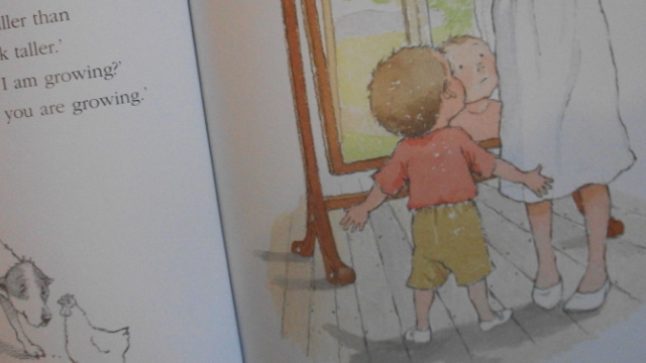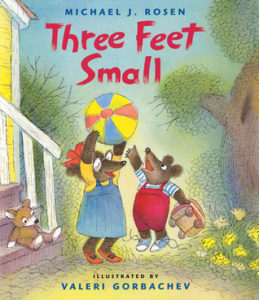Series: Book Ideas
Concept of “Getting Bigger” in The Growing Story and Three Feet Small

The Growing Story and Three Feet Small are two wonderful picture books that address a “math all around us” question that young children find compelling. Both of these stories are built around a question: Am I getting bigger? They also offer rich possibilities for exploring two important Big Ideas of measurement:
- Many different attributes can be measured, even when measuring a single object, and
- Isolating the attribute to be measured is an important precursor to measuring.
The Growing Story by Ruth Krauss, illustrated by Helen Oxenbury, was first published in 1947 but the story is timeless. From early spring through fall, a little boy easily can see how baby chicks, puppies, and plants in the garden grow. But his own growth isn’t nearly as easy to measure—until he finds he has outgrown the warm clothes his mother put away in the spring.
Helen Oxenbury’s warm pastel illustrations will help young readers track precisely how the chicks change in appearance and size; how the rolly-polly puppy becomes a dog; and how the apple tree goes from barren, to bud, to apples ripe for picking. The story links beautifully with an inquiry unit looking at farm animals; it invites rich discussions of how different creatures grow at different rates—a baby chick’s childhood is a matter of months while a human’s lasts for years.
 Michael Rosen’s Three Feet Small, illustrated by Valeri Gorbachev, takes a different tack, but one that is equally important to little ones. The concern about getting bigger is not just a question of physical growth—it has just as much to do with how getting both older and bigger means we can do more things. The little bear who is the center of this book is just not sure that he is growing—especially when he sees all the things his older sister and his adult relatives can do that he is still too little for. However by the end of the book, he also finds that he needs new clothes and that he is beginning to do some of those things that seemed out of his reach earlier.
Michael Rosen’s Three Feet Small, illustrated by Valeri Gorbachev, takes a different tack, but one that is equally important to little ones. The concern about getting bigger is not just a question of physical growth—it has just as much to do with how getting both older and bigger means we can do more things. The little bear who is the center of this book is just not sure that he is growing—especially when he sees all the things his older sister and his adult relatives can do that he is still too little for. However by the end of the book, he also finds that he needs new clothes and that he is beginning to do some of those things that seemed out of his reach earlier.
These books could be used alone or together to open up a wonderful exploration of the benchmarks children can identify concerning what it means to “get bigger”—either in terms of size or abilities. Rosen’s book includes at least one picture showing a measuring chart—if you don’t already have one in the classroom to mark the growth over several months, you could start one now. However, be sure to emphasize that height isn’t the only attribute that shows growth. Include discussion of other physical attributes such as weight. The most emphasis should be put on how we can measure how much we are growing our brains as well as increasing physical abilities. What are things the children know now and can do now that they couldn’t when they were one year old? How about things they couldn’t do at the beginning of the school year?